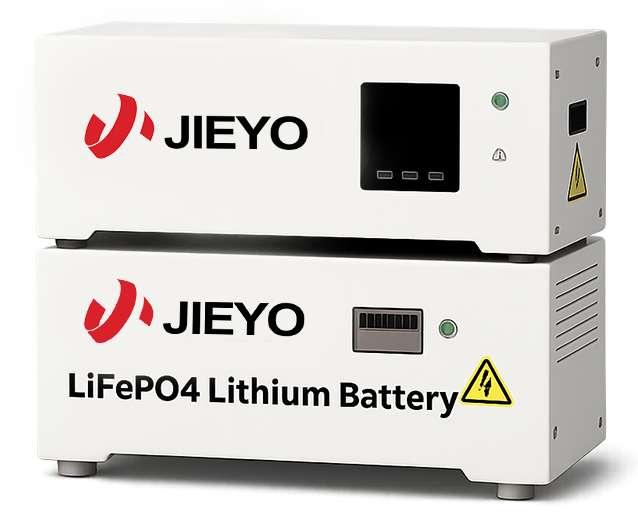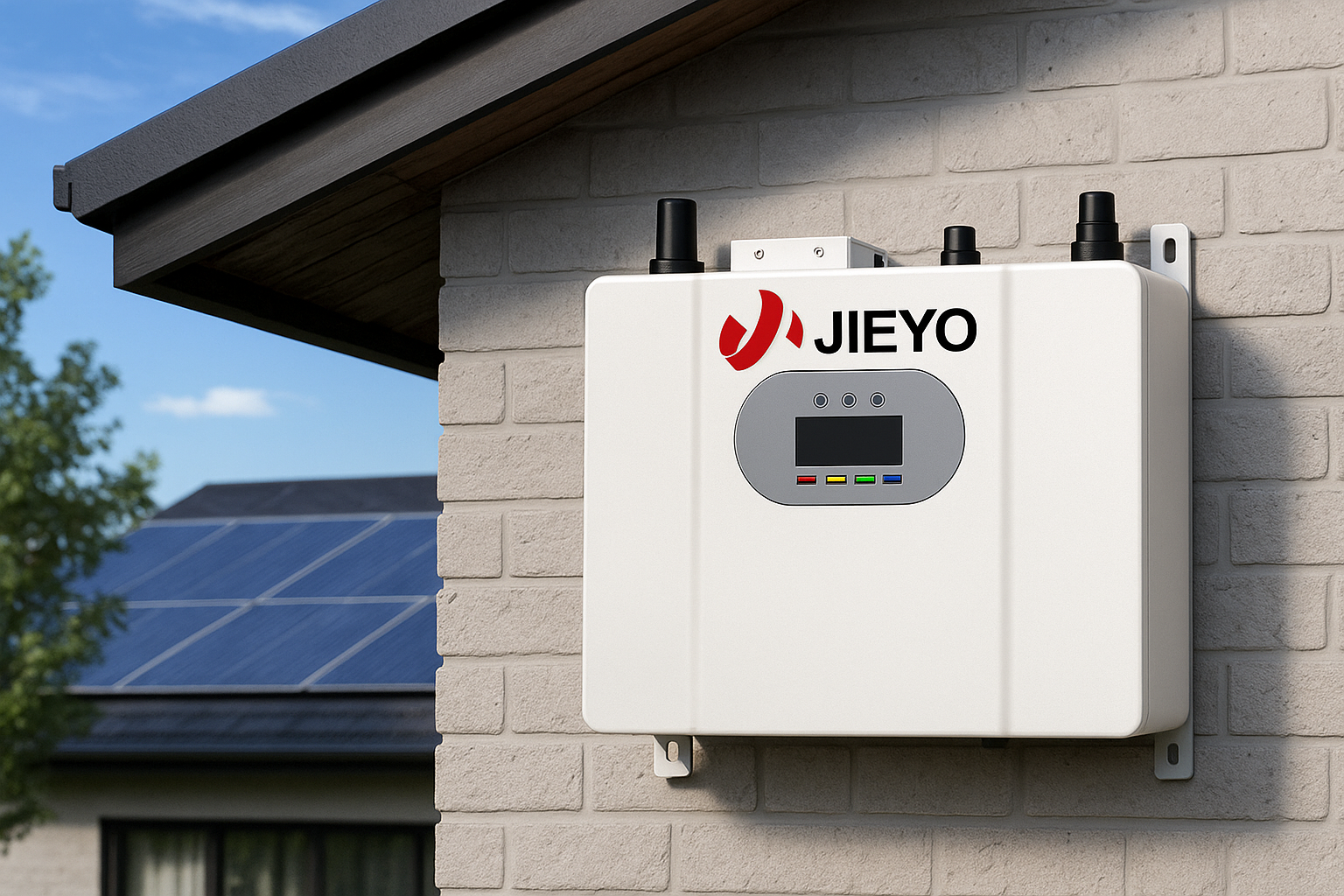Description
JIEYO All-In-One Home Energy Storage System — 5/10/15 kW Hybrid, 51.2 V LiFePO₄, MPPT, 6000+ Cycles
Le JIEYO All-In-One Home Energy Storage System integrates a high-safety LiFePO₄ (LFP) battery, hybrid inverter/chargeret MPPT solar controller inside a single cabinet. It is engineered for residential and light-commercial sites that need dependable backup, PV self-consumption, and peak-shaving—without the wiring complexity of separate boxes. With 51.2 V LFP cells, 6000+ cycle longevity, and CAN/RS485/RS232 communications to mainstream energy gateways, it forms a stable, code-friendly backbone for off-grid, hybrid, or on-grid backup systems.
High-Performance LFP Platform (51.2 V)
-
Chimie : Phosphate de fer lithié (LiFePO₄ / LFP) pour un comportement thermique intrinsèquement stable et une longue durée de vie.
-
Nominal system voltage: 51.2 V (16S LFP).
-
Rated energy options: ≈ 10.24 / 12.8 / 15.36 / 16.07 kWh* per cabinet (model-dependent).
-
Durée du cycle : 6000+ cycles at typical residential DoD profiles.
-
Efficacité de l'aller-retour : high (typ. > 95% with modern hybrids).
-
Faible autodécharge : holds charge during seasonal or emergency standby.
*Exact usable capacity depends on model, DoD setting, and environmental conditions.
Pourquoi choisir LFP pour le stockage à domicile ? Par rapport au NMC et au plomb-acide, le LFP offre une durée de vie supérieure, flatter voltage curve, meilleure stabilité thermiqueet lower lifetime cost per kWh, translating into predictable performance across seasons.
Integrated Power Electronics & AC Output
-
Built-in pure sine wave inverter/charger: 5 kW / 10 kW / 15 kW rated (model-dependent).
-
AC form factor: single-phase 220–240 V 50/60 Hz or 110–120 V 60 Hz (regional variant).
-
Fast transfer to backup output during outages (ATS/UPS behavior; model-dependent).
-
Surge capability sized for household compressors & motors (exact values per model).
-
Clean power for sensitive loads: IT, networking, AV, medical accessories, and appliances.
PV Input & MPPT Harvest
-
Integrated MPPT controller(s): high-efficiency tracking for day-long solar harvest.
-
PV input window (typical): 120–450 Vdc MPPT, ≤ 500 Vdc absolute max (model-dependent).
-
PV power budget: up to 6–10 kW per cabinet depending on tracker count/rating.
-
Flexible strings: supports series strings sized to the MPPT window; combiner/OV protection per code.
-
Self-consumption logic: prioritize PV→load→battery; export rules configurable where permitted.
Smart BMS & System Communications
-
Surveillance des paquets : cell voltage/current/temperature/SOC with active balancing.
-
Protections : over/under-voltage, over/under-temperature, over-current, short-circuit, charge/discharge cutoff.
-
Interfaces : CAN / RS485 / RS232 for closed-loop integration with hybrid inverters and gateways.
-
Event logs & alarms: streamline diagnostics and after-sales support.
-
Mappage du protocole : profiles for popular inverter brands available on request.
Modes de connexion au réseau
-
Hors réseau : autonomous power with PV + battery where utility is unavailable.
-
Réseau hybride : self-consumption, peak-shavinget time-of-use arbitrage; PV charges battery by day, discharge at peak.
-
Sauvegarde sur le réseau : maintain essential circuits via backup output/ATS during outages (per local code).
Ingénierie mécanique et environnementale
-
Cabinet: powder-coated steel/alloy with front service access; floor-standing indoor/outdoor placement.
-
Classe de protection : up to IP55 (model-dependent) for dust/splash resistance.
-
Thermal design: refroidi par air path for quiet, long-life operation; temperature-aware charge/discharge.
-
Facilité d'entretien : modular power & battery bays; field-replaceable submodules reduce downtime.
-
Footprint: compact ≈ 45 × 45 × 60 cm envelope (reference size; varies by power/energy option).
La sécurité dès la conception
-
EV-grade LFP cells with ceramic separators; pack-level fusing and contactors.
-
Pre-charge circuits protect inverter DC link and busbars.
-
Isolement et isolation validated to relevant standards; creepage/clearance respected.
-
Compliance documents: CE / RoHS / UN38.3 / MSDS disponibles pour la logistique et l'entrée sur le marché.
Caractéristiques électriques typiques*
(*Representative values; request a datasheet for final regional specs.)
-
Battery: LiFePO₄, 51.2 V nominal; options ≈ 10.24–16.07 kWh per cabinet.
-
Inverter/charger: 5 / 10 / 15 kW rated pure sine; grid-tie/backup modes per model.
-
AC output: single-phase 220–240 V 50/60 Hz or 110–120 V 60 Hz.
-
PV MPPT: window typ. 120–450 Vdc; PV power ≤ 6–10 kW.
-
Efficacité de l'aller-retour : > 95% (battery + power electronics, typ.).
-
Durée du cycle : ≥ 6000 (typical residential DoD).
-
Operating temps (typ.): charge 0–45 °C, discharge −10–55 °C.
-
Classe de protection : IP55 (cabinet variant).
-
Comms: CAN / RS485 / RS232; vendor protocol selectable by DIP/firmware.
-
Mass (reference): ≈ 45 kg per cabinet (varies with energy/power option).
Applications & Use Cases
-
Residential backup: keep routers, lighting, refrigeration, pumps, PCs online through outages.
-
Solar self-consumption: store daytime PV for evening peaks; reduce grid imports.
-
Small business: peak-shaving and load-shifting for shops, offices, studios.
-
Remote cabins & weak-grid sites: reliable hybrid/off-grid power without fuel.
-
Essential circuits micro-UPS: fast transfer to protected loads for sensitive electronics.
Exemples de dimensionnement du système (à titre d'illustration)
-
5 kW / ~10 kWh: apartments & small homes; Wi-Fi, lighting, IT, refrigeration.
-
10 kW / ~12.8–15.36 kWh: family homes; longer autonomy for fridges, WFH setups, circulation pumps.
-
15 kW / ~16.07 kWh: larger homes/light-commercial; supports heavier simultaneous loads.
Runtime estimate:
Runtime (h) ≈ Capacity (Wh) × DoD × system efficiency / average load (W).
E.g., 16.07 kWh × 0.9 × 0.92 ≈ 13.3 kWh usable → ~13 h at 1 kW average.
Notes sur l'installation et la mise en service
-
Location: place on level floor; allow front/side clearance for airflow and service.
-
AC/DC wiring: follow polarity and torque specs; use rated DC isolators, fuses, and breakers per code.
-
Mise à la terre : bond enclosure and neutral/ground as required by local electrical codes.
-
PV sizing: keep strings within MPPT window and absolute voltage limits; include surge/OV protection.
-
BMS addressing/firmware: confirm inverter profile (CAN/RS485) and DIP settings; update firmware where applicable.
-
SOC sync: first-run full charge to 100% for BMS balancing and SOC calibration.
Maintenance et stockage
-
Quarterly checks: inspect vents, verify busbar torque, review logs for alarms.
-
Thermal care: keep vents clear; avoid sealed closets in hot climates.
-
Stockage à long terme : maintain 40–60% SOC, top-up every 2–3 months.
-
Firmware : apply approved updates for compatibility and optimizations.
What’s in the Crate (Typical)
-
JIEYO All-In-One cabinet (battery + inverter/charger + MPPT)
-
AC/DC installation kit: lugs, gland plates, fasteners (model-dependent)
-
PV/COM cables: CAN/RS485 lead to inverter/gateway (where applicable)
-
Manuel de l'utilisateur et guide de démarrage rapide; basic ATS/backup wiring diagram
(Le contenu varie en fonction de la région et des accessoires sélectionnés.)
Certifications et qualité
-
Safety & transport: MSDS, UN38.3
-
Conformité au marché : CE / RoHS (others on request)
-
Assurance qualité en usine : incoming cell screening, module aging, full functional test with BMS logs; inverter burn-in.
Services OEM / ODM
-
Marque et étiquetage : logo, color accents, nameplates, packaging.
-
Electrical: socket standards, cable lengths, PV/communication connectors, fuse ratings, shutdown interface.
-
Mechanical: custom cabinets, dust filters, outdoor kits, wall-mount or pedestal variants.
-
Mappage du protocole : CAN/RS485 profiles for specific inverter brands; installer integration guides.
Attributs clés (instantané)
-
Product type: All-in-one hybrid ESS cabinet
-
Battery: 51.2 V LiFePO₄, ≈ 10–16 kWh per cabinet
-
Power electronics: 5/10/15 kW pure sine inverter/charger, MPPT solar controller
-
Classe de protection : up to IP55
-
Communications : RS485 / CAN / RS232
-
Durée du cycle : 6000+ cycles (typ.)
-
Use: Residential / Commercial / Industrial backup & PV self-consumption
-
Origin: Guangdong, Chine
-
OEM/ODM : Available
Pour qui ?
-
Homeowners seeking quiet, safe backup with PV integration and room to grow.
-
Installers standardizing on a single-cabinet 51.2 V platform that cuts wiring time.
-
Project buyers requiring documented LFP safety and CAN/RS485 integration.
-
Businesses aiming to reduce bills via peak-shaving and time-of-use strategies.















